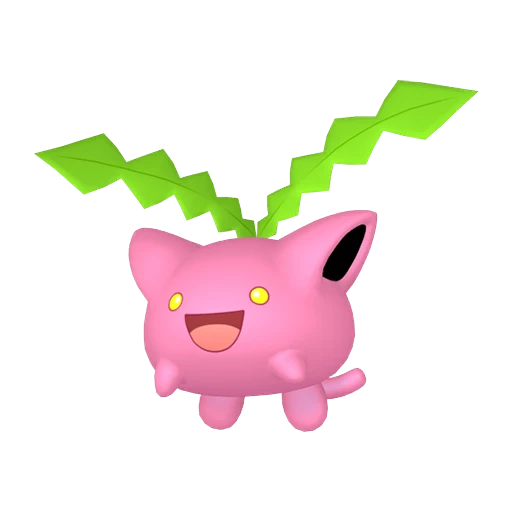
Hoppip
(2) : generation-ii
Hoppip (#187) is a Grass- and Flying-type Pokémon known for its buoyant, pink body and leafy head that lets it drift on the wind like a living dandelion seed. This light-as-air Pokémon often floats in groups, riding breezes to distant places. Fun fact: Hoppip uses its roots to anchor itself to the ground on windy days, so it doesn’t get blown away!
Votes
1
Favorites
0
Caught
0
1-1
50.00%
Votes for Hoppip
Bio
Hoppip: The Complete Biography of Pokémon #187
Hoppip, known as the “Cottonweed Pokémon,” is a beloved creature in the Pokémon universe. Recognized for its adorable pink appearance and buoyant nature, Hoppip is a dual-type Grass/Flying Pokémon introduced in Generation II. With its Pokédex number #187, Hoppip captivates Trainers and collectors alike, thanks to its unique abilities, stats, evolution line, and rich lore. In this comprehensive biography, we’ll dive deep into everything you need to know about Hoppip, from its origins and lore to its stats, evolution, and trading card history.
Hoppip at a Glance
- Pokédex Number: #187
- Type: Grass / Flying
- Category: Cottonweed Pokémon
- Height: 1’04” (0.4 m)
- Weight: 1.1 lbs (0.5 kg)
Hoppip Lore: Origins and In-Game Description
In the Pokémon world, Hoppip is renowned for its light, cottonweed body, which allows it to float effortlessly in the wind. According to Pokémon lore, Hoppip often gather in groups, holding hands to avoid being blown away by even the gentlest breezes. This behavior is not only charming but also demonstrates the Pokémon's social nature and reliance on teamwork.
Pokédex entries highlight Hoppip’s unique adaptation to windy environments. It uses its leaves to sense changes in the air, and when strong winds approach, it anchors itself firmly to the ground with its roots. Hoppip’s ability to ride the wind is a recurring motif in its lore, symbolizing both vulnerability and adaptability.
Hoppip Stats: Base Stats and Competitive Value
When evaluating Hoppip stats, it’s clear that this Pokémon is designed more for utility and support than for direct combat. Here is a breakdown of its base stats:
- HP: 35
- Attack: 35
- Defense: 40
- Special Attack: 35
- Special Defense: 55
- Speed: 50
While Hoppip’s stats may seem modest, its access to status moves like Leech Seed, Sleep Powder, and Stun Spore make it a useful partner in certain battle strategies, especially in lower-tier competitive play or in-game progression.
Hoppip Evolution: From Hoppip to Jumpluff
The Hoppip evolution chain is a classic example of growth and transformation in the Pokémon series. Here’s how Hoppip evolves:
- Hoppip (#187): The starting form, found in grassy fields and meadows.
- Skiploom (#188): Hoppip evolves into Skiploom at level 18. Skiploom features a larger, flower-like head and even greater buoyancy.
- Jumpluff (#189): At level 27, Skiploom evolves into Jumpluff, completing the evolution chain. Jumpluff is known for its three cotton-like puffs, which allow it to travel vast distances on the wind.
The Hoppip evolution line is famous for its whimsical designs and strategic utility in battle, especially as Jumpluff, which can learn a wide range of disruptive moves.
Hoppip in the Trading Card Game
The Hoppip trading card is a favorite among collectors and TCG players. Since its debut in the Neo Genesis set, Hoppip has appeared in numerous expansions, often depicted in serene, grassy settings or floating gently in the breeze. Hoppip trading cards are typically Grass-type, and some offer helpful abilities such as status infliction or deck searching, reflecting Hoppip’s in-game moves and supportive nature.
Collectors value Hoppip cards for their charming artwork and the nostalgia associated with Generation II Pokémon. In competitive play, certain Hoppip cards are sought after for their synergy with Skiploom and Jumpluff cards, making them essential in decks designed around the Hoppip evolution family.
Hoppip in Popular Culture and Spin-Off Games
Beyond the mainline Pokémon games, Hoppip has made appearances in various spin-off titles, including Pokémon GO, Pokémon Mystery Dungeon, and the Pokémon anime. Its floating, care-free nature makes it a memorable character, often depicted as lighthearted comic relief or as a symbol of hope and renewal.
Conclusion
Hoppip, the Grass/Flying Pokémon with Pokédex number #187, is much more than a simple, breezy creature. Its lore speaks to the importance of adaptation and community, while its stats and evolution line offer unique opportunities for creative battle strategies. Whether you’re seeking to complete your Pokédex, build a themed deck with the Hoppip trading card, or explore the deeper lore behind this cottonweed Pokémon, Hoppip remains a cherished part of the Pokémon world.
For fans, collectors, and Trainers alike, Hoppip is a gentle reminder that even the lightest Pokémon can leave a lasting impression.







